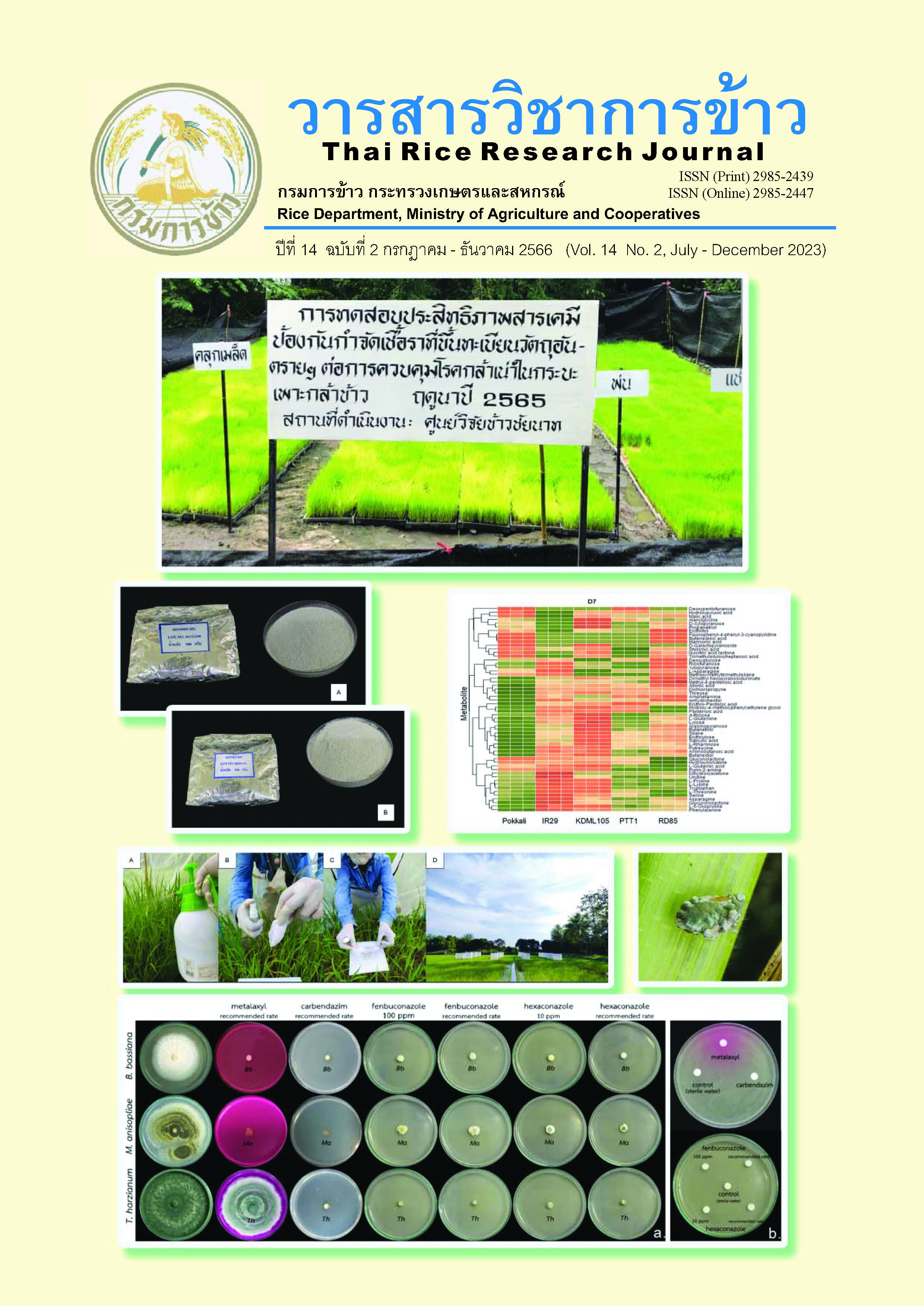การพัฒนาข้าว กข47 และ กข49 ให้มีความหอมและปริมาณอมิโลสต่ำ โดยใช้เครื่องหมายโมเลกุลในการคัดเลือก
Main Article Content
บทคัดย่อ
พันธุ์ข้าว กข47 และ กข49 เป็นพันธุ์ข้าวผลผลิตสูง นิยมปลูกในนาชลประทาน แต่ไม่มีความหอม และมีปริมาณอมิโลสสูง งานวิจัยนี้มีวัตถุประสงค์เพื่อพัฒนาพันธุ์ข้าว กข47 และ กข49 ให้มีความหอมและปริมาณอมิโลสต่ำสำหรับใช้ปลูกในพื้นที่นาชลประทาน ดำเนินการโดยวิธีการผสมกลับและใช้เครื่องหมายโมเลกุล aroma (badh2) ในการคัดเลือกลักษณะความหอม ลักษณะอมิโลสใช้เครื่องหมายโมเลกุล Waxy (Wxb) การพัฒนาประชากรโดยวิธีการผสมกลับ ประชากรชั่ว F1-BC3F1 คัดเลือกลักษณะพันธุกรรมแบบ heterozygous และในประชากร BC3F2-BC3F5 คัดเลือกลักษณะพันธุกรรมแบบ homozygous ในตำแหน่งยีนเป้าหมาย ผลการคัดเลือกยีนความหอม และปริมาณอมิโลสสามารถแบ่งสายพันธุ์ข้าวได้เป็น 6 กลุ่ม ได้แก่ (1) กลุ่มที่มียีนความหอม และปริมาณอมิโลสต่ำ (badh2, Wxa) มี 14 สายพันธุ์ มาจาก กข47 จำนวน 8 สายพันธุ์ และจาก กข49 จำนวน 6 สายพันธุ์ (2) กลุ่มที่มียีนความหอมและปริมาณอมิโลสปานกลาง (badh2, Wxa) 13 สายพันธุ์ (3) กลุ่มที่มียีนความหอมและปริมาณอมิโลสสูง (badh2, Wxa) 40 สายพันธุ์ (4) กลุ่มที่ไม่มียีนความหอมและปริมาณอมิโลสต่ำ (Badh2, Wxb) 1 สายพันธุ์ (5) กลุ่มไม่มียีนความหอมและปริมาณอมิโลสปานกลาง (Badh2, Wxa) 2 สายพันธุ์ และ (6) กลุ่มไม่มียีนความหอมและปริมาณอมิโลสสูง (Badh2, Wxa) 24 สายพันธุ์ และได้สายพันธุ์ PSL17018-19-1-2-3 ที่มีความหอม ปริมาณอมิโลสต่ำ และมีฐานพันธุกรรมเหมือน กข49 ให้ผลผลิตสูง 1,156 กิโลกรัมต่อไร่
Article Details
เอกสารอ้างอิง
กรมการค้าต่างประเทศ. 2566. ข้อมูลการส่งออกข้าว. สืบค้นจาก: https://www.ditp.go.th/contents_attach/780244/780244.pdf. (25 มกราคม 2566)
ปาริฉัตร รัตนผล. 2555. การปรับปรุงพันธุ์ข้าวให้มีลักษณะไม่ไวต่อช่วงแสงผลผลิตสูง และเมล็ดมีคุณภาพดีโดยวิธีบันทึกประวัติร่วมกับการใช้เครื่องหมายดีเอ็นเอช่วยในการคัดเลือก. วิทยานิพนธ์ปริญญาโท. มหาวิทยาลัยเกษตรศาสตร์, กรุงเทพฯ.
ศรีสวัสดิ์ ขันทอง, ชัชวาล จันทราสุริยารัตน์ และสุรีพร เกตุงาม. 2553. โรคไหม้และการปรับปรุงพันธุ์ข้าวให้ต้านทานโรคไหม้โดยใช้เครื่องหมายโมเลกุลช่วยในการคัดเลือก. Thai Journal of Genetics 3: 106-119.
สุรีพร เกตุงาม. 2557. การปรับปรุงพันธุ์พืชระดับโมเลกุล. โรงพิมพ์มหาวิทยาลัยอุบลราชธานี, จ.อุบลราชธานี. 308 หน้า.
Ayres, N.M., A.M. McClung, P.D. Larkin, H.F.J. Bligh, C.A.Jones and W.D. Park. 1997. Microsatellite and a single-nucleotide polymorphism differentiate apparent amylose classes in an extended pedigree of US rice germplasm. Theoretical and Applied Genetics 94(6): 773-781.
Buttery, R.G., L.C. Ling, B.O. Juliano and J.G. Turnbaugh. 1983. Cooked rice aroma and 2-acetyl-1-pyrroline. Journal of Agricultural and Food Chemistry 31: 823-826
Collard, B.C.Y., M.Z.Z. Jahufer, J.B. Brouwer and E.C.K. Pang. 2005. An introduction to makers, quantitative trait loci (OTL) mapping and marker-assisted selection for crop improvement: the basic concepts. Euphytica 142: 169-196.
Juliano, B.O., 1971. A simplified assay for milled-rice amylose. Cereal Science Today 16: 334-338, 340, 360.
Sano, Y. 1984. Differential regulation of waxy gene expression in rice endosperm. Theoretical and Applied Genetics 68(5): 467-473.
Vanavichit, A., T. Yoshihashi, S. Wanchana, A. reekit, D. Saengsraku, W. Kamolsukyunyong, J. Lanceras, T. Toojinda and S. Tragoonrung. 2004. Positional cloning of Os2AP, the aromatic gene controlling the biosynthetic switch of 2-acetyl-1-pyrroline and gamma aminobutyric acid (GABA) in rice. Proceedings of the 1st International Conference on Rice for the Future. August 31-September 3, 2004. Bangkok.
Wanchana, S., W. Kamolsukyunyong, S. Ruengphayak, T. Toojinda, S. Tragoonrung and A. Vanavichita. 2005. A rapid construction of a physical contig across a 4.5 cM region for rice grain aroma facilitates marker enrichment for positional cloning. ScienceAsia 31: 299-306.
Wanchana, S., T. Toojinda, S. Tragoonrung and A. Vanavichit. 2003. Duplicated coding sequence in the waxy allele of tropical glutinous rice (Oryza sativa L.). Plant Science 165: 1193-1199.
Wang, Z.Y., F.Q. Zheng, G.Z. Shen, J.P. Gao, D.P. Snustad, M.G. Li, J.L. Zhang and M.M. Hong. 1995. The amylose content in rice endosperm is related to the post-transcriptional regulation of the Waxy gene. Plant Journal 7: 613-622.

